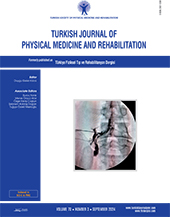Effects of Tai Chi exercise on pain, functional status, and quality of life in patients with osteoarthritis or inflammatory arthritis
2 Department of Environmental and Occupational Health and Sports, Andrija Štampar School of Public Health, Zagreb, Croatia
3 Patient Advocacy Association, Zagreb, Croatia
4 Croatian Wushu Federation, Zagreb, Croatia
5 Department of Physiotherapy, University of Applied Health Sciences, Zagreb, Croatia DOI : 10.5606/tftrd.2024.13140 Objectives: This study aims to assess the impact of a Tai Chi exercise program (TCEP) on pain, spinal flexibility, muscle strength, stability and balance, functional status, and quality of life (QoL) among home-dwelling patients with osteoarthritis (OA) or inflammatory arthritis (iA).
Patients and methods: Between October 2018 and April 2019, a total of 28 participants (4 males, 24 females; median age: 62 years; range, 34 to 79 years) who completed the training program participating in at least 18 sessions were included. The TCEP consisted of 50 sessions for 60 min twice a week. The average attendance rate was high (78%, 39 sessions).
Results: Chest mobility (breathing index, p<0.001), sagittal mobility of cervical (p<0.001), thoracic (p=0.009), and lumbar spine (Schober`s test, p<0.001) improved significantly in participants with OA and iA. The improvement in functional status was significant only in participants with OA (Lequesne index, p=0.014). Although the change in Lequesne index was statistically significant, the median value remained in the range of severe disability and the change did not reach the minimal clinically important difference. Although the trends were positive, the changes in pain (Visual Analog Scale pain, p=0.599), stability and balance (functional reach test, p=0.341), muscular strength (wall sit test, p=0.069), and health-related QoL (15D, p=0.065) were non-significant in participants with OA and iA.
Conclusion: Our study results suggest that a 25-week TCEP is safe and can improve chest and spinal mobility in home-dwelling individuals with OA or iA.
Keywords : Arthritis, muscle strength, postural balance, physical functional performance, Tai Chi

















